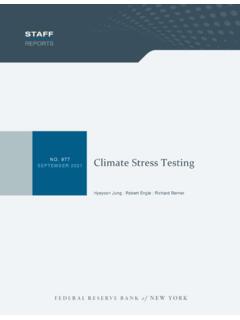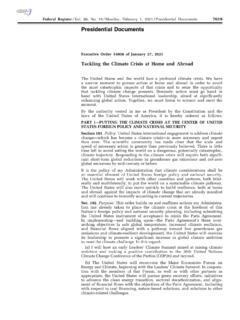Transcription of ESG Investing and Climate Transition - OECD
1 SUSTAINABLE AND RESILIENT FINANCE. OECD Business and Finance Outlook 2020. The OECD Business and Finance Outlook is an annual publication that presents unique data and analysis on the trends, both positive and negative, that are shaping tomorrow's world of business, finance ESG Investing and Climate Transition and investment. The COVID 19 pandemic has highlighted an urgent need to consider resilience in finance, both in the financial system itself and in the role played by capital and investors in making economic and social systems more dynamic and able to withstand external shocks. Using analysis from a wide range of perspectives, this year's edition focuses on the environmental, social and governance (ESG) factors that are rapidly becoming a part of mainstream finance. It evaluates current ESG practices, and identifies priorities and actions to better align investments with sustainable, long term value in particular, the need for more Market Practices, Issues and Policy Considerations consistent, comparable and available data on ESG performance.
2 SUSTAINABLE AND RESILIENT FINANCE. OECD Business and Finance Outlook 2020. PRINT ISBN 978-92-64-38456-9. PDF ISBN 978-92-64-54453-6. ESG Investing and Climate Transition Market Practices, Issues and Policy Considerations PUBE. OECD (2021), ESG Investing and Climate Transition : Market Practices, Issues and Policy Considerations, OECD Paris, This document is published under the responsibility of the Secretary-General of the OECD. The opinions expressed and arguments employed herein do not necessarily reflect the official views of OECD member countries. This document, as well as any data and map included herein, are without prejudice to the status of or sovereignty over any territory, to the delimitation of international frontiers and boundaries and to the name of any territory, city or area. OECD 2021. 3. Foreword The growth of sustainable finance, including the increasing array of financial products, has attracted the attention of investors, policy makers, and various stakeholders in civil society as to its potential to deliver financial returns, align with societal values, and contribute to sustainability and Climate -related objectives.
3 In particular, ESG Investing has become a leading form of sustainable finance, and has shifted from early stages of development toward mainstream finance in a number of OECD jurisdictions, and generally refers to the process of considering environmental, social and governance (ESG) factors when making investment decisions. ESG ratings, which are applied to companies representing around 80% of market capitalisation in 2020, have evolved in recent years to incorporate long-term financial risks and opportunities in investment decision making processes. At the same time, the environmental E' pillar score of ESG rating is being increasingly used as a tool to align investments with a low-carbon Transition , and a range of financial market products and measurement approaches have developed to help investors align portfolios with specific Climate -objectives and strategies in line with the Paris agreement . Despite noteworthy progress, considerable challenges remain that hinder the potential for these approaches to support long-term value and Climate -related international objectives, notably with respect to ESG Investing .
4 Challenges include, the promulgation of different approaches, data inconsistencies, lack of comparability of ESG criteria and rating methodologies, as well as inadequate clarity over how ESG. integration affects asset allocation. Ultimately, these challenges could constrain the pace and scale of the capital allocation needed to achieve tangible progress to support long-term value and a Transition to low-carbon economies. Therefore policies should be considered to foster global interoperability and comparability of ESG approaches, as well as to strengthen the tools and methodologies that underpin disclosure, valuations, and scenario analysis in financial markets associated with a low-carbon Transition . This report, which serves as a contribution to the G20 Sustainable Finance Working Group in 2021, highlights the main findings from recent OECD research on ESG rating and Investing . It offers policy considerations to strengthen ESG practices to foster global interoperability and comparability, as well as encourage greater alignment of environmental metrics with a low-carbon Transition .
5 This work represents part of a broader body of work to monitor developments in sustainable finance and ESG rating and Investing . The report and accompanying analysis has been prepared by Catriona Marshall, Robert Patalano and Riccardo Boffo from the OECD Directorate for Financial and Enterprise Affairs, and has benefited from valuable discussions with delegates of the OECD Committee on Financial Markets. 4 . Executive Summary Amid public sector initiatives to reach the objectives of the Paris agreement and the Sustainable Development Goals (SDGs), there has been a sharp growth in investors' use of ESG approaches, including the incorporation of Climate Transition factors into investment decisions. In turn, ESG Investing has become a leading form of sustainable finance for long-term value and alignment with societal values, and has evolved from its early stages of development to mainstream Investing in a number of OECD. jurisdictions. The environmental E' pillar score of ESG rating is being increasingly used as a tool to align investments with a low-carbon Transition , and could in principle help unlock valuable forward-looking information on firms' Climate Transition risks and opportunities.
6 Also, a number of financial market products and practices have emerged to align capital flows with the low-carbon Transition . These encompass instruments for issuers, third party ratings, principles and guidance, as well as index and portfolio products to help channel financing to transitioning entities, and better price the risks and opportunities of the Transition . Notwithstanding noteworthy progress, there remain considerable challenges that hinder the efficacy of these approaches, and notably ESG Investing , to support long-term value and Climate - related international objectives. These challenges include the promulgation of different approaches, data inconsistencies, lack of comparability of ESG criteria and rating methodologies, as well as inadequate clarity over how ESG integration affects asset allocation. This report will further address progress, challenges, and policy considerations, with respect to the following: First, on strengthening the comparability of ESG rating and Investing approaches, and improving the quality of data used for investment decisions.
7 ESG ratings often lack transparency in their calculation and differ substantially in the metrics on which they draw, as well as the methodologies used in their calculation, raising questions as to the extent to which their aggregation contributes to long-term value. Methodologies also tend to differ substantially across rating providers, and result in a lack of correlation between ESG ratings supplied by different providers. Therefore policies are needed to ensure global transparency, comparability and quality of core ESG metrics in reporting frameworks, ratings, and definitions of ESG investment approaches. Second, on improving the alignment of the environmental pillar of ESG ratings with a low-carbon Transition . Inconsistencies in the construction of ESG ratings across providers, the multitude of different metrics measured in one E pillar score, and insufficient quality of forward looking metrics prevent them from supplying consistent and comparable information on Transition risks and opportunities across firms and jurisdictions.
8 Notably, rating providers appear to place less weight on negative environmental impacts while placing greater weight on the disclosure of Climate -related corporate policies and targets, with limited assessment as to the quality or impact of such strategies. Such limitations could hinder the use of E pillar scores by investors with an aim to align portfolios with the low-carbon Transition . Greater transparency and precision of the meaning of sub-category scores and metrics could contribute to better alignment of E pillar scores 5. with a specific purpose, such as to assess Climate Transition risks and opportunities, or broader environmental impacts. Such clarity would allow investors with specific sustainability goals to use ESG approaches as a more effective tool for portfolio rebalancing and risk management. Third, to strengthen the integration of Climate Transition risks and opportunities into market frameworks and products in a manner that enhances market efficiencies to support an orderly low-carbon Transition .
9 While markets are beginning to price Transition risks and opportunities due to progress on Climate -related financial disclosures, they remain constrained by a number of impediments, from uncertainties that undermine pricing of externalities to inadequate disclosures of forward looking metrics on net-zero pathways. In particular, the effective market pricing of the positive and negative valuation impacts of a Transition is hampered by insufficient data, including financially material metrics and analytical tools to measure and manage Transition risks, and lack of policy clarity regarding carbon pricing and support for renewables. Moreover, market products and measurement instruments will need to further evolve to allow investors to better align portfolios with specific Climate -objectives and strategies, from divestment to active engagement and assessment of ways to strengthen the veracity of Transition plans. These competing dynamics and challenges associated with ESG rating and Investing could compromise market integrity, erode investor confidence, and mask the extent of environmental and Climate -related impacts of investment decisions.
10 Ultimately, challenges could constrain the pace and scale of the capital allocation needed to achieve tangible progress to support long-term value and a Transition to low-carbon economies. Therefore policies should be considered to foster transparency and comparability of ESG approaches, as well as to strengthen the tools and methodologies that underpin disclosure, valuations, and scenario analysis in financial markets associated with a low-carbon Transition . On ESG disclosure frameworks and approaches: Ensure global interoperability and comparability and quality of core ESG metrics in reporting frameworks, ratings, and investment practices to address global fragmentation. Frameworks should utilise standardised core metrics to form baseline reporting for the E, S and G pillars for use by market participants. Strengthen relevance of ESG metrics through alignment with long-term enterprise value, including environmental and social factors that become material over time.
















